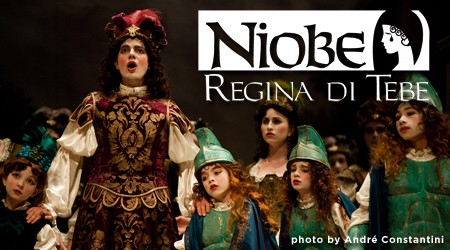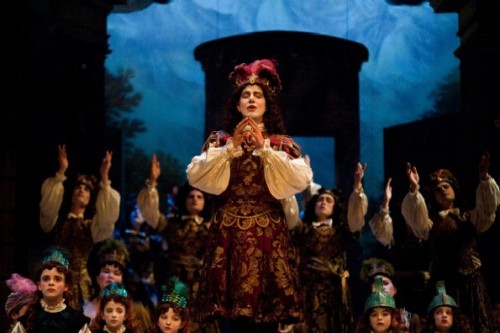The Boston Early Music Festival's Niobe
At the Mahaiwe in Great Barrington June 24 and 25
By: David Bonetti - Jun 16, 2011
“Niobe, Regina di Tebe” (1688)
Music by Agostino Steffani
Libretto by Luigi Orlandi, after Ovid’s “Metamorphoses”
Musical directors: Paul O’Dette and Stephen Stubbs
Stage director: Gilbert Blin
Choreogrpahers: Caroline Copeland and Carlos Fittante
Costume designer: Anna Watkins
Set designer: Gilbert Blin
Lighting director: Lenore Doxsee
Cast:
Niobe, Queen of Thebes: Amanda Forsythe
Anfione, King of Thebes: Philippe Jaroussky
Clearte, a Theban Prince: Kevin D. Skelton
Manto, a Theban maiden: Yulia Van Doren
Tiberino, son of the King of Alba: Colin Balzer
Tiresia, a soothsayer and priest of Latona: Charles Robert Stephens
Creonte, son of the King of Thessaly: Matthew White
Poliferno, Prince of Attica, a magician: Jesse Blumberg
Nerea, Niobe’s nurse: Jose Lemos
The Boston Early Music Festival Orchestra|
The Boston Early Music Festival Dance Ensemble
Additional performances: Friday, June 17 at 7:00 p.m. & Sunday,
June 19 at 3:30 p.m. at the Cutler Majestic Theatre, Boston
Friday and Saturday, June 24 & 25 at 7 p.m., Mahaiwe Performing Arts Center, Great Barrington
For tickets and more information: www.bemf.org or 617-868-2363
He came, he sang, he conquered. That would be, of course, Philippe Jaroussky, the tall, thin, boyishly handsome French counter-tenor who is the closest thing early music has to a superstar. At the Cutler Majestic Theatre Tuesday night in the obscure 17th century opera “Niobe, Regina di Tebe,” he not only lived up to his reputation (and his YouTube videos) but exceeded it – there is nothing like a live voice singing in real time and space. His voice is preternaturally sweet, but as he demonstrated in the variety of arias written for his character, Anfione, King of Thebes, he was also able to express anger and something approaching existential despair. His character, an uneasy monarch, renounces his throne, meditating in the manner of Shakespeare’s Richard II on the heavy weight of absolute power. His voice was both powerful and ravishingly dulcet. His singing and his physical performance – highly mannered in the Baroque style all the actors assumed – was incredibly nuanced. Listening to him was like going to countertenor heaven.
This was fortunately not the kind of production where the star of the evening casts in shadow the lesser lights revolving around him. The entire cast was stellar. Particularly so was Boston favorite Amanda Forsythe, who essayed a more dramatic role than the lyrical and comedic characters she ordinarily plays. Not immediately winning vocally, she ultimately conveyed the complexities of her character - Niobe the Queen of Thebes, whose pride before the gods leads to her undoing - from being one of the original royal bitches to a grieving mother crying over the bodies of her dead children, her husband’s suicide and her own transformation into a stone. In her two duets with Jaroussky, their voices melded, so similar in timbre that they sang as one, their lovely sounds interweaving into a tightly knit whole.
Such moments were all too rare, however. For all its strengths - the nonpareil vocal cast, the rhythmically alert orchestra, the historically authentic sets and costumes, the thoroughly mastered formalized acting style and dancing - the evening was a long one with many dry and boring patches.
The fault lay not with the Boston Early Music Festival, for which early music lovers remain grateful for its archeological work resuscitating neglected operas, but with the work itself. Steffani (1653-1728) was a well-positioned and privileged composer (and later in life, diplomat and bishop!). Born in the Veneto, where modern opera developed, and heir to Claudio Monteverdi and Francesco Cavalli, he was court composer in Munich and then Hanover, two German courts eager to establish Italian opera houses. During the past 50 years of the early music revival, as works by his precursors (Monteverdi, Cavalli, Jean-Baptiste Lully), peers (Alessandro Scarlatti, Henry Purcell) and successors (Antonio Vivaldi, George Frideric Handel, Jean-Philippe Rameau) are increasingly revived by major opera companies and often dazzlingly recorded, his dozen or so operas have remained in limbo.
If “Niobe” is typical of his operatic work, there seem to be two main reasons for his obscurity, each of them fatal in themselves: they are undramatic and they lack that touch of musical genius that makes Baroque opera accessible to modern audiences despite its exotic and dated conventions.
Dramatically, all the action of Ovid’s familiar story of Niobe - who brought on the wrath of the gods by flouting her fecundity, and was punished by having the source of her hubris, her children, shot down in a public square by Diana and Apollo, her husband commit suicide upon seeing them sprawled upon the pavement and herself turned to stone in her grief – takes place in the last half hour of the four-hour long work. (The BEMF production clocked in at than three hours, 45 minutes with one 15-minute intermission after the company made significant cuts.) The first three hours of the work are cluttered with subsidiary plot lines – the love of Tiberino and Manto; the thwarted love for Niobe of Clearte, a Theban noble; the anger of the soothsayer Tiresias; the military aggression of Creonte, the king of neighboring Thessaly; and the scheming of the magician Poliferno, who bewitches Creonte, convincing him that he is Mars, etc. etc. etc., many of them of less than compelling interest.
There is lovely music composed for all the characters. In opposition to Italian style, Steffani wrote arias that are brief bursts of melody without development or da capo returns to the original theme. Modern audiences that chafe at the slowness of the Baroque vocal traditions and often wish to see the fully developed da capo aria cut off before the repeat, might regret that desire after they encounter the Steffani model. The briefness, indeed brusqueness, of the melody leads to a sameness that becomes boring – those development sections are crucial to the dramatic progress of the emotional story being told and the da capo sections often register the change that occurred in the central section. Here there is no development, no growth, just arietta after arietta, melody after melody, some 60 altogether, which end up sounding interchangeable. What’s a delight the first time heard is tedious the fifth.
Few of the arias rise above the average. Although the different characters are musically differentiated, there are few breakout arias that define a character memorably (and make Baroque opera exciting). Those that occur are welcome. Most of them were written not for the title character but for her mopey spouse, Anfione, which I guess that is to our benefit, since it gave Jaroussky the opportunity to display his vocal gifts a couple of times.
Perhaps the greatest scene in the opera, certainly the most memorable, is when Anfione, alone in his study, sings of his desire for privacy and the pursuit of meditation. Addressing the spheres, with which he seeks harmony, he sings with eloquence of the desire even those most enamored of power must sometimes feel to be alone with themselves and their own thoughts. In this beautifully staged scene, the lights bathing the reflective King in shadows and his children circling him slowly holding globes of different sizes, Jaroussky displays his amazing vocal skill as if it is the easiest thing in the world to spin out perfectly produced, fully rounded sound.
The solo scene shifts to an encounter with his faithless wife, who in a beautiful duet pours out her love for him in rapturous tone. As he sings “My light, my eyes,” she asserts her love: “I want to delight you always/I want to be with you always/My heart has no peace, no well-being/ It lives in constant pain/When it is far from you, my faith.” All lies of course, but if the opera had more sequences like these two, it would be a candidate for widespread revival.
Jaroussky gives full expression to Anfione’s existential doubt in the next act when he soulfully sings an aria that asks, “Where am I? Who will help me?” As Colin Timms puts it in the program notes, “He trembles to staccato chords and weeps to chromatic scales.” The most despairing aria in the work, it places Anfione with Shakespeare’s Richard II and even Hamlet. Again, Jaroussky nails it, revealing a passion the rest of the opera has little time for.
And Jaroussky shows how butch his countertenor can be later in the same act, when showing dramatic inconsistency, he takes on the arms of war and vows vengeance against the forces threatening Thebes. Here, his sweet countertenor becomes almost frightening.
Wonderful moments, all of them, but all too brief and all too few.
As mentioned above the entire cast was excellent. The Russian-American soprano Yulia Van Doren as Manto, the professional virgin who finds love, was particularly sweet voiced. (This was the role Forsythe sang last year in London when “Niobe” was staged at Covent Garden.) Van Doren had shown her chops the night before in more lively music in a concert at Jordan Hall given by the Montreal-based “Les Voix Baroques.” There she was joined by the Canadians Colin Blazer, who sang Tiberino, and Matthew White, who sang Creonte in “Niobe.” Both made good impressions with what they had to sing here, but they had more to play with in the concert of music based on “The Song of Songs.”
Kevin D. Skelton as Clearte, Charles Robert Stephens as Tiresia, and Jesse Blumberg as Poliferno were all fine.
The only disappointment was Jose Lemos as Nerea, the almost obligatory drag role in Venetian-derived opera. In a comic role, he got laughs whenever he offered his Eve Ardenish commentary, but he underplayed the camp. And this was an opera that needed some comic relief. A few more hands on the hip, rolls of the eyes and doubletakes would have been welcome. Perhaps the directors encouraged him to be subtle – if they did, it was a mistake. Baroque composers totally understood and exploited camp – how could they not when half their casts were castrati! No need to undercut it here – or is that a lingering legacy of the origin in the United States of early music as a cultural extension of the Unitarian Church? (Director Gilbert Blin, who got the rest of it right, is from France, where I doubt New England Unitarianism has made much of a dent.)
In any case, the theatrical values overseen by Blin were correct. The staging and costuming could have been plucked from paintings and prints of the era. Even the dance, choreographed by Caroline Copeland and Carlos Fittante, which in the Baroque era was limited to hops, skips, funny high stepping and lots of circle dancing, was entertaining. For once, Steffani’s taste for short bursts paid off: the dances were brief and often integrated into the action. (It should be noted that Steffani didn’t compose the dance music: that was relegated to Melchior d’Ardespin, Bavarian court orchestra director.)
Many thanks to the BEMF for doing such a great job of bringing us a North American premiere and for giving Philippe Jaroussky and Amanda Forsythe starring roles. Most likely we’ll never get to see or hear “Niobe, Regina di Tebe” again. For those who love early opera it is a check off a list (even if Steffani was never on the list to begin with) and added historical knowledge to experience. If anything, it helps us appreciate Cavalli, Lully, Scarlatti, Handel and Rameau all the more.
During the 2013 festival, the BEMF is mounting Christoph Graupner’s “Antiochus und Startonica,” another rarity. Mark your calendars: June 9-16. And keep your fingers crossed.



